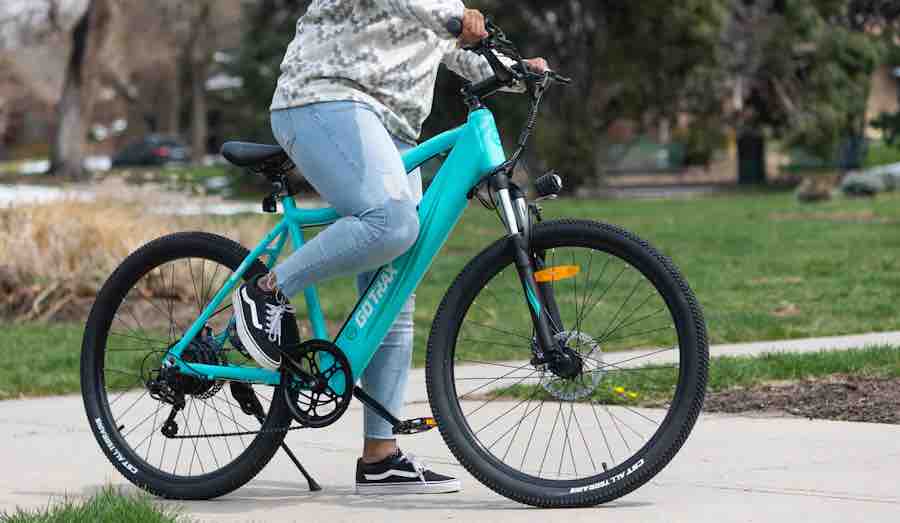

E-Bikes: Promoting Health or Encouraging Laziness?
Most of my friends probably cannot believe that I have not written on this subject sooner. They have heard me rave, time after laborious time, about how obnoxious e-bikes are out on the rec paths of Summit County, Colorado where we live. They have heard me fume about the unconscionable behaviour exhibited by the many visitors to our wonderful state who rent these accurst contraptions and then flaunt every single law of rec path etiquette and basic common sense. They are, I tell anyone who will listen, an inherent menace to themselves and others, endangering all who encounter them. But the reason I haven’t written about e-bikes before now is because despite all my fanatical ramblings in my more immoderate moments of consideration, I can actually see the other side of this whole discussion, and even at this moment, recognize that we have to find some balance with these things because they aren’t going anywhere anytime soon.
That’s because more and more e-bikes are being sold every year. In just the 3-year period from 2109 to 2022, e-bikes sales in the United States nearly quadrupled from 287,700 in 2019 to just over 1.1 million in 2022. And the same is true on a global level going forward. The global e-bikes market reached around 36.5 million units in 2022, but according to statista.com is projected to climb at a compound annual growth rate of just under 10 percent between 2022 and 2030, to reach just under 77.3 million e-bikes by 2030. And the financial forecast for the e-bike rental market is much the same, with exponential growth set to occur over the next decade or so. In other words, we should all expect to see a whole lot more e-bikes out on our local rec paths.
And in some sense, that can be a positive thing. Given America’s declining propensity for exercise and burgeoning bellies, anything that can encourage us to get out and moving should be a good thing. As of 2022 the percent of adults age 18 and older who met the Physical Activity Guidelines for both aerobic and muscle-strengthening activity was a scant 24.2%. Once we fall into that vicious cycle of weight gain which then makes it harder to exercise which, of course leads right back to more weight gain, it can be very challenging to extricate oneself from it. Getting out and going for a 20 mile bike ride just isn’t an option for someone who hasn’t exercised in nearly a decade or more. E-bikes provide a healthy incentive to get up off the couch and go live life again. They are the transition vehicle for those who want to make a difference in their lives but don’t know where to start.

But that is exactly the point- they should be the transition vehicles, not the end destination. Just as many of us went from riding a bike with training wheels until we were capable of riding a real bike, so too should e-bikes be the intermediary folks use to be able to ride a traditional bike. E-bikes are a great tool for folks who have grown too old or too heavy to engage in traditional exercise, but more and more they are becoming an excuse for people who just don’t feel like having to pedal a bike. I can’t tell you how often I ride by a pack of healthy-looking 20-somethings flying by me on e-bikes, oblivious to the rules of the road or any other concern of the community-at-large. And that’s where this story takes a significant turn for the worse.
With a power-assist motor that can travel at speeds of up to 40mph and more without even hardly touching the pedals, we are not giving these people a bike as much as we are a motorcycle. Then we are letting them out onto rec paths intended for and still mainly used by human-powered bicycles and walkers. The very notion of the e-bike is that it is marketed towards the biking novice who knows little about handling a bike or interacting with the others that are travelling the road. Would you hand over the keys of a Bugatti Cheron to your 15 year old student driver? Of course you wouldn’t, but we hand over a motorised bicycle to anyone who wants one without a single course on bike handling or etiquette. And when they’re going 35mph and you’re going 10mph, guess who’s going to get hurt…
The estimate of emergency room visits from e-bike accidents from 2017 to 2022 is 53,200, representing 15 percent of the total micromobility injury estimate during the same period. And given the proliferation of e-bikes, that number just keeps expanding year after year. Research indicates that the increase in injuries linked to micromobility devices such as e-bikes is almost 21% from 2021 to 2022. Since 2017, micromobility-related injuries have risen, with an estimated average annual growth of 23%. But we just keep on putting more and more of them out there, regardless of the consequences.
Listen, I want everyone out there to go explore their world and have some fun getting exercise. E-bikes are a great way to do just that. But we need to ensure that the people riding them handle them with the same care and responsibility they would any other motorised vehicle. That way when they come here to Summit County, they don’t have to send me ducking for cover on the rec path.
Steven Craig is the author of the best-selling novel WAITING FOR TODAY, as well as numerous published poems, short stories, and dramatic works. Read his blog TRUTH: In 1000 Words or Less every THURSDAY at www.waitingfortoday.com






I would like to add that bike helmets are only rated to 12 mph, so anyone going faster on an e-bike (or an ordinary bike) will spill their brains on head impact with the road.